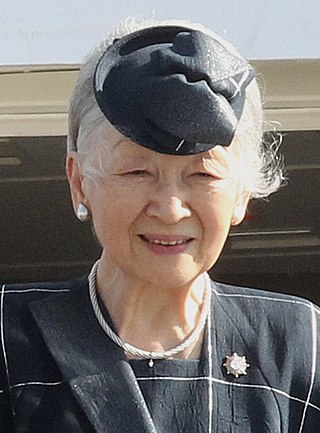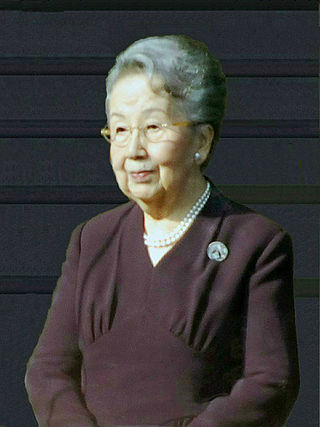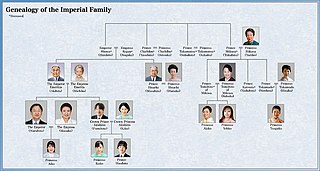
Michiko is a member of the Imperial House of Japan. She was Empress of Japan as the wife of Akihito, the 125th Emperor of Japan reigning from 7 January 1989 to 30 April 2019.

Gakushūin University is a private university in Mejiro, Toshima, Tokyo. It was re-established after World War II as tertiary component of the Gakushūin School Corporation as privatized successor to the original Gakushūin University was established during the Meiji period to educate the children of the Japanese nobility. It is still one of the most prestigious universities in Japan, counting most of the members of the present Imperial Family among its former or present students. The average number of students is capped so that each student can receive personal attention from the staff.

Masako is Empress of Japan as the wife of Emperor Naruhito, who ascended to the Chrysanthemum Throne following his father's abdication in 2019.

Oeyo (於江与), Gō (江), Ogō (小督) or Satoko (達子) : 1573 – September 15, 1626) was a prominently-placed female figure in the Azuchi–Momoyama period and early Edo period. She was a daughter of Oichi and the sister of Yodo-dono and Ohatsu. When she rose to higher political status during the Tokugawa shogunate, she took the title of "Ōmidaidokoro". Following the fall of the Council of Five Elders, Oeyo and her sisters were key figures in maintaining a diplomatic relationship between the two most powerful clans of their time, Toyotomi and Tokugawa. Due to her great contributions to politics at the beginning of the Edo period she was posthumously inducted into the Junior First Rank of the Imperial Court, the second highest honor that could be conferred by the Emperor of Japan.

Fumihito, Crown Prince Akishino is the younger brother and heir presumptive of the Emperor of Japan, Naruhito, and the younger son of Emperor Emeritus Akihito and Empress Emerita Michiko. Since his marriage in June 1990, he has had the title Prince Akishino and has headed his own branch of the imperial family.

Kiko, Crown Princess Akishino, is the wife of Fumihito, Crown Prince of Japan. Her husband is the younger brother and heir presumptive of Emperor Naruhito and the second son of Emperor Emeritus Akihito and Empress Emerita Michiko.

Princess Tomohito of Mikasa is a member of the Japanese Imperial Family as the widow of Prince Tomohito of Mikasa.

Yuriko, Princess Mikasa, is a member of the Imperial House of Japan as the widow of Takahito, Prince Mikasa, the fourth son of Emperor Taishō and Empress Teimei. The Princess is the last surviving paternal great-aunt by marriage of Emperor Naruhito, and currently is the oldest member of the imperial family, and the only living member who was born in the Taishō era.

Princess Akiko of Mikasa is a member of the Imperial House of Japan and the elder daughter of Prince Tomohito of Mikasa and Princess Tomohito of Mikasa (Nobuko). She is also the niece of Japan's 92nd prime minister Tarō Asō, great-niece of author and literary critic Ken'ichi Yoshida, and great-granddaughter of Japan's 45th prime minister Shigeru Yoshida.

The Gakushūin, or Gakushuin School Corporation (学校法人学習院), historically known as the Peers' School, is a Japanese educational institution in Tokyo, originally established as Gakushūjo(学習所) to educate the children of Japan's nobility. The original school expanded from its original mandate of educating the social elite and has since become a network of institutions which encompasses preschool through tertiary-level education.
The first Japanese students in the United Kingdom arrived in the nineteenth century, sent to study at University College London by the Chōshū and Satsuma domains, then the Bakufu (Shogunate). Many went on to study at Cambridge University and a smaller number at Oxford University until the end of the Meiji period. The primary motive for this was an effort to modernise Japan in the long run. Since the 1980s, Japanese students in the United Kingdom have become common thanks to cheaper air travel.

From 2001 to 2006, Japan discussed the possibility of changing the laws of succession to the Chrysanthemum Throne, which is currently limited to males of the Japanese Imperial Family.

The Imperial House, also referred to as the Imperial Family and the House of Yamato, is the imperial family of Japan, consisting of those members of the extended family of the reigning Emperor of Japan who undertake official and public duties. Under the present Constitution of Japan, the emperor is "the symbol of the State and of the unity of the people". Other members of the Imperial Family perform ceremonial and social duties, but have no role in the affairs of government. The duties as an emperor are passed down the line to their male children. This Japanese monarchy is the oldest continuous hereditary monarchy in the world.

Prince Hisahito of Akishino is the youngest child and only son of the Crown Prince and Crown Princess of Japan. He is the nephew of Emperor Naruhito and second in line to the throne after his father, Fumihito.
The Imperial Household Council is a ten-member body to approve the statutory matters on the Imperial House of Japan. The Council was established in 1947, when the current Imperial Household Law took effect.
The current line of succession to the Chrysanthemum Throne is based on the Imperial Household Law. At present, only direct male-line males are allowed to ascend the throne.

The 2019 Japanese imperial transition occurred on 30 April 2019 when the then 85-year-old Emperor Akihito of Japan abdicated from the Chrysanthemum Throne after reigning for 30 years, becoming the first Emperor of Japan to do so since Emperor Kōkaku in 1817. This marked the end of the Heisei era and the inception of the Reiwa era, and saw numerous festivities leading up to the accession of his eldest son and successor, Emperor Naruhito. The Enthronement Ceremony took place on 22 October 2019. Akihito's younger son, Prince Akishino, is his brother's heir presumptive. The ceremony cost 16.6 billion Yen.

The Akasaka Estate is a park-like Japanese Imperial Estate, site of several major existing and former Imperial residences in the district of Moto-Akasaka, Minato Special Ward, Tokyo. Besides Prince Hitachi, who lives in Higashi, Shibuya, and the Emperor Emeritus, who lives in Takanawa Residence until April 2022, many members of the Imperial Family have their official residence on this estate, currently including the Emperor himself. The estate is not accessible to the general public.














